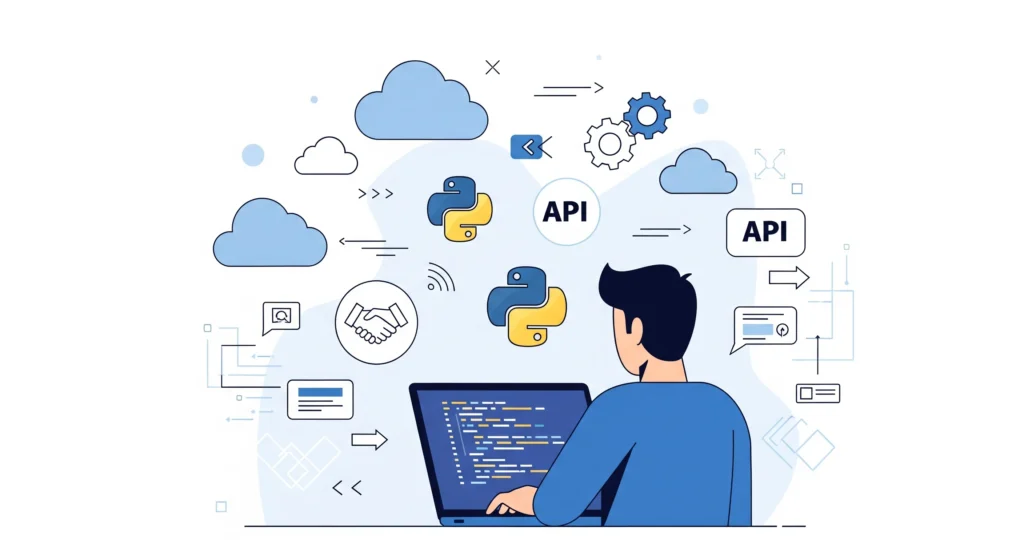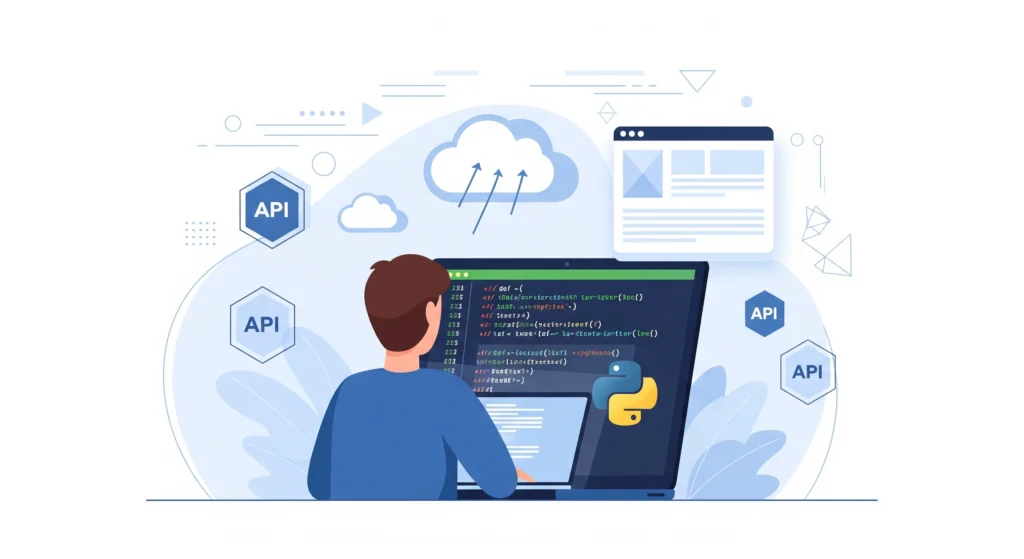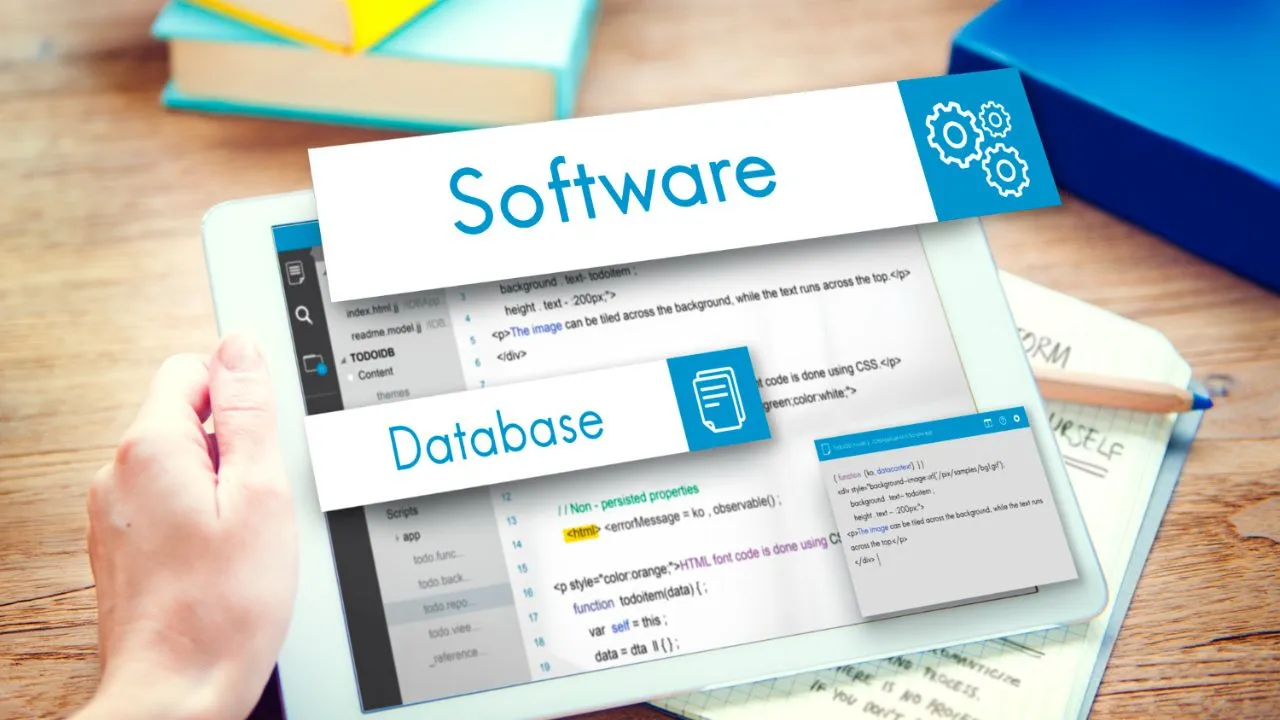As the bar for performance continues to rise, users now expect web apps to handle everything from everyday traffic to sudden spikes, underscoring the need for flexible and scalable technical solutions. This is where Python and HTMX come into play. Python, an increasingly popular coding language that is easy to learn, and HTMX, an emerging JavaScript framework that can be lean on resources, can be used to build scalable web applications that meet modern production and development expectations without stressing developers or their resources.
This article aims to give you an in-depth view of building Web Apps with Python using HTMX that covers their benefits, cases, architecture, techniques for performance optimization, real-world applications, and understanding how Python and HTMX function together to build applications that are efficient, scalable, and easy to develop and maintain.
What is HTMX?
HTMX is a modern front-end tool that helps developers create interactive web apps just by using basic HTML attributes. It eliminates the need for heavy JavaScript frameworks while providing the same types of interactivity and responsiveness. Instead of reloading everything, it updates just the necessary content from the server in real time.
Key Features of HTMX:
- Simple Implementation with existing HTML
- Support for AJAX, WebSockets, and Server-Sent Events
- Only requires little to no JavaScript
- Keeps the application lightweight and latency-free
- Supports server-driven user interface updates
- Works well with any server-side language
HTMX is putting the simplicity back in front-end development by providing a means to simplify the toolchain and make large code bases more maintainable. HTMX allows developers to keep the front end lean with minimal JavaScript, while also providing the interactive experience normally achieved by complex JS frameworks. It works effortlessly with Python web apps that focus on rendering pages directly from the server.
Why Use Python for Web App Development?

Python is one of the most widely used programming languages around the world. Its simple syntax, rich library support, and ability to draw upon large communities also make it a favorite for creating robust web apps using Python.
Benefits of Using Python:
- Readability and simplicity- Easy to understand for both beginners and seasoned developers
- Scalability- Scalable to handle an influx of traffic or a growing network of user adoption.
- Rich Ecosystem- Frameworks such as Django and Flask allow dedicated python developers and designers to build on a powerful tool set that allows for fast development and deployment.
- Security- Python includes built-in security components that limit potential risk to common exploits and vulnerabilities.
- Cross-platform Support- Python is maintained across different operating systems, allowing for increased flexibility when deploying solutions.
- Community Support- Large portions of tutorials, packages, and tools found on the internet are available to accelerate development time frames using Python with HTMX.
Python presents multi-faceted tools for web application development by providing a powerful back end with a lightweight and dynamic front end using HTMX. If you’re considering building Web Apps with Python, this duo is a top choice.
Why HTMX + Python Web Development Services are a Winning Combination
When creating interactivity for applications, developers have typically relied on full JavaScript frameworks such as React or Vue. While these frameworks are powerful, they also come with a great deal of overhead.
HTMX breaks that cycle and provides the same capability without all the overhead. Furthermore, when you combine it with Web Apps with Python, especially when leveraging a framework like Django or Flask, you can:
- Keep business logic on the back-end
- Load only what is needed (partial rendering)
- Facilitate SEO (server-side rendered pages)
- Write less code and make progress faster
- Streamline both development and maintenance
The combination results in a highly useful development experience along with a very responsive user interface-a great advantage to both startups and established enterprises.
How HTMX and Python Web Apps Work Together
Consider a product listing page where users can simply click “Load more” to seamlessly fetch and view more products. Instead of reloading the entire page or working hard to write elaborate JavaScript, HTMX does all the hard work for you:
- You call a Python endpoint with hx-get
- When you click the button, HTMX makes the request
- Python returns the required HTML snippet t
- HTMX inserts it into the existing page
It’s that simple — everything happens in smooth steps without needing to page reload. The same applies to forms, filters, search bars, and everything you typically find on a webpage.
Dynamic behavior makes it much easier to build interactive web apps using Python while maintaining good performance.
Picking the Right Python Framework
When developing Web Apps with Python, you have a choice of a framework. Here are two commonly used frameworks:
Django:
- Come with batteries included
- best for large-scale applications
- Built-in ORM, admin panel, and authentication
- Works seamlessly with HTMX for rendering templates
Flask:
- Minimal
- Lightweight and flexible
- Ideal for small to mid-sized applications
- Gives you more control with a bit of flexibility
- Can be used with HTMX easily for partial rendering
Both frameworks can work with HTMX, so your project’s complexity and goals should guide your choice.
Creating Scalable Architecture using HTMX and Python

Scalability refers to your application’s capability to grow in terms of users, data, and actions without losing speed.
The reasons why HTMX + Web Apps with Python do this well:
- Stateless Servers: Simple Horizontal Scaling
- Updates are Efficient: HTMX only rerenders parts of the page
- Async Python: With tools like FastAPI, you can maintain many connections at once
- Database Optimization: With Django ORM and SQLAlchemy, you can make your database queries efficient
- Task Queues: You can create background jobs with Celery and Redis
- Cloud-Ready: Python applications can be run on any cloud provider using Docker and source control
These capabilities allow your Python web apps to remain responsive under high traffic.
Performance Tips for HTMX + Web Apps with Python
Want to stay fast? Here are some best practices:
- Cache common data
- Use CDNs for static content
- Use select_related or prefetch_related with DB queries
- Use lazy loading with HTMX (hx-trigger=”revealed”)
- Use Prometheus, Sentry, or New Relic to monitor the health of your app
These practices are useful for ensuring performance on your web apps using Python —even at scale.
Real-World Applications
Here’s where this tech stack really shines:
- E-commerce – Full reloads should be avoided, as carts, filters, and stock information can all be updated without reloading the page.
- Healthcare Portals – More secure and interactive options for managing appointments and records.
- Online Learning – Live quizzes, updating progress, updating content, etc.
- Admin Dashboards – Real-time analytics using HTMX with WebSockets, although this type of real-time analytics is still very popular.
- SaaS Platforms – Fast and efficient with a well-thought-out design from MVP, then only scale easily over time.
These use cases are evidence to support that Web Apps with Python and HTMX offer options to be production-ready, flexible, and efficient.
SEO and Accessibility Advantages
HTMX is good for SEO because the content is rendered on the server-side and not hidden behind JavaScript. This means:
- Search engines might index your pages
- Faster loading times will help rankings
- Content is still accessible and readable
This also enhances accessibility for screen readers and users with limited internet access.
Developer Productivity & Cost Benefits.
The beauty of HTMX with Python web development services is how much easier development is. Modern workflows can even integrate AI tools to create custom agents for automating testing, content updates, and repetitive coding tasks, saving even more time.
- Shared codebase = faster delivery
- Minimal front-end overhead = fewer bugs
- Lower costs of hiring/training
- No need for large front-end teams
This is why many businesses are moving to a model for both MVPs and full applications.
Built-In Security
Python frameworks offer robust security features:
- CSRF tokens
- SQL Injection handling
- Authentication/Authorization systems
- Secure cookies management
HTMX integrates smoothly with these features and doesn’t introduce new vulnerabilities.
Best Practices for Scalable Web Apps with Python
To get the most out of this stack, for your app:
- Keep code modular and well-documented
- Optimize database performance
- Use HTMX when you need
- Implement unit tests
- Implement integration tests
- Deployment via CI/CD
- Actively monitoring bottlenecks
These best practices not only future-proof your application and reduce maintenance headaches.
Why More Teams Trust HTMX + Python
This tech stack continues to increase in use—and for good reason. You get the reliability of Python with the flexibility of HTMX to build apps that are fast, scale quickly, and are easier to manage. If you need assistance building your project, you can trust Aegis Softtech’s world-class Python Web Development Services from the planning stage, through development, to scaling your app.
Conclusion
By leveraging HTMX with Web Apps with Python, you have access to a smarter way to build. You receive:
- Rapid development cycles
- Lightweight and maintainable code
- Scalable performance
- Great user experiences
Regardless of whether it’s an internal tool, MVP, or global SaaS application, etc., this combination can give you all of this.
So, ready to get started? Reach out to Aegis Softtech’s Python web development Services today and build something scalable, secure, and future-proof.
FAQs
Q1: Is HTMX suitable for large-scale apps?
Yes. HTMX keeps your front-end light so it scales great with server-side technologies, such as Python.
Q2: Can HTMX replace React or Angular?
Yes, in some way. HTMX gracefully handles interactivity and outperforms JavaScript frameworks because you don’t have the cost associated with the framework overhead.
Q3: Are Web Apps with Python scalable?
Yes! With trending tools like FastAPI, Django, and async capabilities, Python is a solid foundation for scalable apps.
Q4: Who uses Python in the real world?
Companies like Instagram, Reddit, Dropbox, and Spotify are deploying Python web apps in production.
Q5: How quickly can I build using this stack?
You can launch a working MVP in weeks and scale as demand grows.
Still need help? Check out Aegis Softtech’s Python Web Development Services to make your vision a reality.






